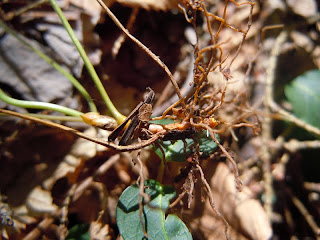Some of the books I use to gather information. I also have a few internet sources which I use on occasion - but the internet is mostly useful for positive identification of plants. Most field guides and books do not offer adequate descriptions or photographs. Oh, I am missing my Peterson's Wild Edibles field guide. I cannot find it and I am afraid I will have to buy another since it's a really great book.
Also on my wish list:
This looks like a great read and good resource.
This last one is by Steve Brill, a sometimes urban forager who lives in downstate NY. He is a pretty cool guy and this book is loaded with plants - one of the best collections I have seen. He also does a great job of telling you how to prepare them.
Of course there a a hundred other books I want to read as well.
The Mayapples in May
I forgot to post up this picture of my Sensitive Ferns prior to cooking.
Goldthread flower. This plant is also called Mouth Root and Savoyane, which is derived from a Micmac word meaning "dye for skins".
Goldthread leaves. The leaves, roots and stems make a yellow dye which can be used for dying quills, leather, wool and I would imagine many other things as well.
The bright yellow roots (of course they are even brighter in person) of Goldthread. This plant derives it's name of Mouth Root from it's long standing reputation for healing mouth thrush and canker sores. If you have a sore mouth, grab some of these roots and start chewing. The plant has also been used to treat deafness and eye infections. It was traded heavily at one time by European colonists in North America.
Indian Cucumber. This is a delightful vegetable to munch on while you are out in the woods. It yields a crisp white root with a delightful texture and a sweet cucumber taste. The root becomes sweeter towards the fall and is sometimes so sugary it tastes like candy.
As always, be cautious when you are using either Goldthread or Indian Cucumber - they are both threatened species. Unfortunately a lot of our native plants are threatened due to invasive species, pollution and urbanization. It is important to respect and preserve these plants.
Painted Trillium









No comments:
Post a Comment